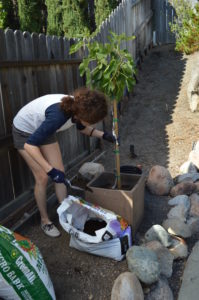Microclimates in the Garden
California has more microclimates than most other parts of the world; the Golden State is home to beaches, mountains, valleys, desserts, and even a temperate rainforest. The term “microclimate” refers to the climate in a small, specific area that is different from the climate of the surrounding area. Sounds simple. While microclimates are relatively small things, they can have a big impact, even for home gardeners. Even in your own garden you probably have more than one microclimate. For example, you may have found that some parts of your garden are windier, warmer, or more vulnerable to frost than other parts. Those are the effects of microclimates—and you can use them to your advantage.
 To identify the different microclimates in your garden, you can set one thermometer in a permanent location and then move a second thermometer to different locations in the garden each day, recording the different temperature readings at the same time of day. You will probably find a difference of several degrees in various locations and you can take advantage of that difference in deciding where to plant certain things. As a general rule, however, there are certain areas that typically create predictable microclimate conditions. Look for the following spots in your garden to make suitable planting choices.
To identify the different microclimates in your garden, you can set one thermometer in a permanent location and then move a second thermometer to different locations in the garden each day, recording the different temperature readings at the same time of day. You will probably find a difference of several degrees in various locations and you can take advantage of that difference in deciding where to plant certain things. As a general rule, however, there are certain areas that typically create predictable microclimate conditions. Look for the following spots in your garden to make suitable planting choices.
South- and West-Facing Walls
These areas are likely to be among the warmest spots in your garden. Walls and fences (particularly when made of stone or masonry) absorb heat through the day, keeping the area warmer into the night. Use heat-loving plants here, such as tomatoes, pomegranates, guavas, and other edibles that need heat to ripen fruit.
North-Facing Walls
These areas are cool and best for shade-loving or woodland plants. In hot-summer parts of the state, plant shrubs like hydrangeas, viburnum, or other plants that might burn with too much direct sun.
East-Facing Walls
These areas get morning sun so plants that like light but not too much heat, such as azalea, rhododendron, and fuchsia, prosper here.
This area will provide a bit of shelter and a few more degrees of warmth during a frost. Use this area for frost-tender plants or move container plants here during a period of frost for extra protection.
At the Bottom of a Slope
Cold air will flow down a slope and hang in the low ground below, which makes that area unsuitable for frost-tender plants but better for plants that need more chill hours to set flowers or fruit, such as peonies or apples.
Understanding and exploiting microclimates is one more way you can take advantage of the particular features of your garden and use them to the best effect.
